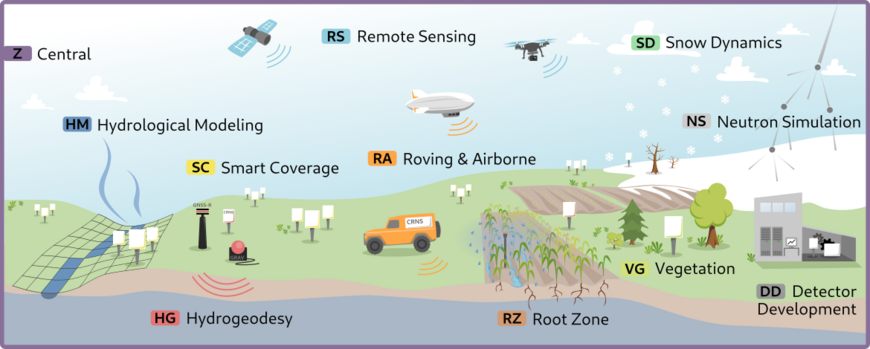Overview
Cosmic Sense is an interdsiciplinary and transregional research unit funded by DFG, which will investigate how and where soil moisture in small catchments changes due to precipitation, evapotranspiration and deep percolation, but also how other water pools such as vegetation and snow change.
The aim of the Cosmic Sense project is to make measurements over a large integration area. For this purpose the Cosmic Sense makes massive use of the cosmic-ray neutron sensing technique, which detects fluctuations of neutron intensities at the landsurface resulting from high-energy particles from space and hydrogen distribution in the soil and on the land surface. The further improvement of the method is accompanied by numerical modelling and detector development.
The work will help to better understand general processes of the water cycle, such as the recharge of new groundwater and soil moisture patterns in landscapes. Additionally, the basic insights about the distribution of water between atmosphere, soil, groundwater and vegetation will be transfered into models, practical applications and other investigation areas.
Mission of Cosmic Sense
The exchange of water between atmosphere, biosphere, and hydrosphere can be viewed as a result of complex interactions of dynamic feedback mechanisms, where soil moisture content acts as the key state variable. Approaches are required to handle land surface complexity and scale dependency of water fluxes. State-of-the-art observations of soil moisture content are ranging from continuous point-scale measurements via field-scale snapshots to remote sensing products on the basin scale and beyond. They have to deal with a space-time trade-off since the measurement frequency typically decreases with the covered spatial scale.
We aim at bridging existing gaps between scales through additional techniques and sources of information about the soil water storage. Cosmic-Ray Neutron Sensing (CRNS) measures the presence of water by sensing changes in neutron density above the ground. We will develop a quantitative, adaptable, and transferable approach for observing representative soil moisture content values on the field scale while accounting for other dynamic water pools on the land surface, such as biomass, interception, and snow. Furthermore, we will transfer the mapping of soil moisture to larger scales with sensor clusters and mobile neutron detectors.
We aim at bridging gaps between disciplines. CRNS will function as a unique combination of invasive and non-invasive observations in joint field campaigns. The measurement and interpretation of soil moisture by CRNS requires advanced knowledge of soil hydrology as well as particle physics including neutron transport modeling. Engineering efforts will be made for detector development that aims to substantially improve the temporal resolution and spatial coverage.
Our approach is especially tailored to resolve the discrepancy in support volume and timing between hydrological models and field observations. Comprehensive observations by CRNS, remote sensing and complementary methods will be used concertedly with hydrological and land-surface models at the regional scale to infer also groundwater recharge and atmospheric fluxes. Thereby, models and observations together will allow for identifying patterns and processes at the scale of small catchments with unprecedented spatio-temporal resolution.

